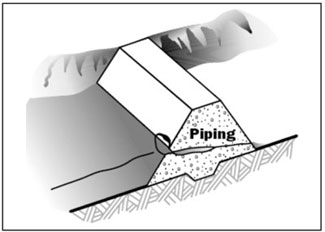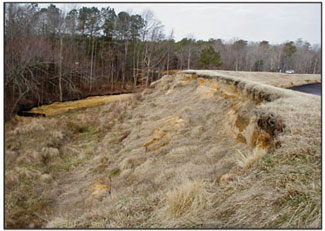Pocket Safety Guide for Dams
and Impoundments
Dam Problems
- Sinkholes
- Slide, Slump, or Slip
- Broken Down or Missing Riprap
- Erosion
- Trees or Obscuring Vegetation
- Rodent Activity and Animal Impact
Probable Causes and Possible Consequences
- Internal erosion of embankment materials or the
foundation (piping) can cause a sinkhole.
- An eroded cavern (cave-in) can result in a sinkhole.
- A small hole in the wall of an outlet pipe can develop into
a sinkhole.
- Water with sediment at the exit indicates erosion of the
dam.
- Piping can empty a reservoir through a small hole in the wall. It also can lead to dam failure as soil pipes develop and erode through the foundation or a pervious part of the dam.
Recommended Action
Report the suspected problem to the appropriate Federal or State agency official immediately.
- Inspect other parts of the dam that may be susceptible to seepage or more sinkholes.
- Check seepage and leakage outflows for muddy water.
- Have a qualified engineer inspect the conditions, identify the exact cause of sinkholes, and recommend further actions.
- Depending on the location of the sinkhole in the embankment, have the reservoir drawn down as necessary.
 Figure 5—Sinkholes. |
 Figure 6—Whirlpool action is an indication of advanced piping. |
Probable Causes and Possible Consequences
- Foundation movement or a too steep slope can cause
earth or rocks to move along a slip plane which can lead
to a slump of the embankment.
- Slide movements in the reservoir basin can lead to inlet obstruction or dam failure.
Recommended Action
Report the suspected problem to the appropriate Federal or State agency official immediately.
- Evaluate the extent of the slide.
- Monitor the slide.
- Draw down the reservoir level if the safety of the dam is threatened.
- Have a qualified engineer inspect the conditions and recommend further actions.
 Figure 7—Slide, slump, or slip. |
 Figure 8—Slumping on the downstream face of a dam. |
Probable Causes and Possible Consequences
- Poor-quality riprap deteriorates and does not protect the slope.
- Wave or ice action can displace riprap allowing erosion of the bank.
- Similar-sized round rocks may roll downhill and expose the slope.
- Wave action against these unprotected areas decreases the embankment width.
Recommended Action
- Reestablish the normal slope.
- Place bedding material and properly sized riprap to protect against wave action.
 Figure 9—Broken down or missing riprap. |
 Figure 10—Wave erosion on the unprotected face of a dam. |
Probable Causes and Possible Consequences
- Water from intense rainstorms or snowmelt carries
surface materials down the slope and results in
continuous troughs, which can be hazardous if allowed
to continue.
- Erosion can lead to deterioration of the downstream slope and failure of the structure.
Recommended Action
- If erosion is detected early, add protective grasses that may resolve the problem.
- Protect eroded areas; add rock or riprap, which is the preferred method.
 Figure 11—Erosion. |
 Figure 12—Erosion on the downstream face of a dam. |
Probable Causes and Possible Consequences
- Natural vegetation (bushes) obscures visual inspection and harbors rodents.
- Large tree roots can create seepage paths.
- Large trees can blow over during a storm and damage the dam, which may cause a breach.
Recommended Action
- Control vegetation that obscures visual inspection of the embankment.
- Remove all large, deep-rooted trees and shrubs on or near the embankment.
- Backfill voids properly.
- Remove trees at the toe of the dam to provide a 25-foot buffer.
 Figure 13—Trees or obscuring vegetation. |
 Figure 14—Trees growing on the crest and the faces of a dam. |
Rodent Activity and Animal Impact
Probable Causes and Possible Consequences
- Cattail-filled areas and areas where trees are close to
the reservoir provide ideal habitat and foraging areas for
animals.
- An overabundance of rodents increases the chance of
animal burrowing, which creates holes, tunnels, and
caverns.
- Tunnels may reduce the required length of the seepage
path, which could cause a piping problem.
- Tunnels can lead to the collapse of the dam crest and may cause dam failure.
Recommended Action
- Start a rodent control program to reduce the population and prevent future damage to the dam.
- Determine the exact location and extent of tunneling.
- Backfill existing rodent holes with suitable well-compacted material to repair damages.
 Figure 15—Rodent activity |
 Figure 16—Rodent holes in the dam face can cause dam failure. |

